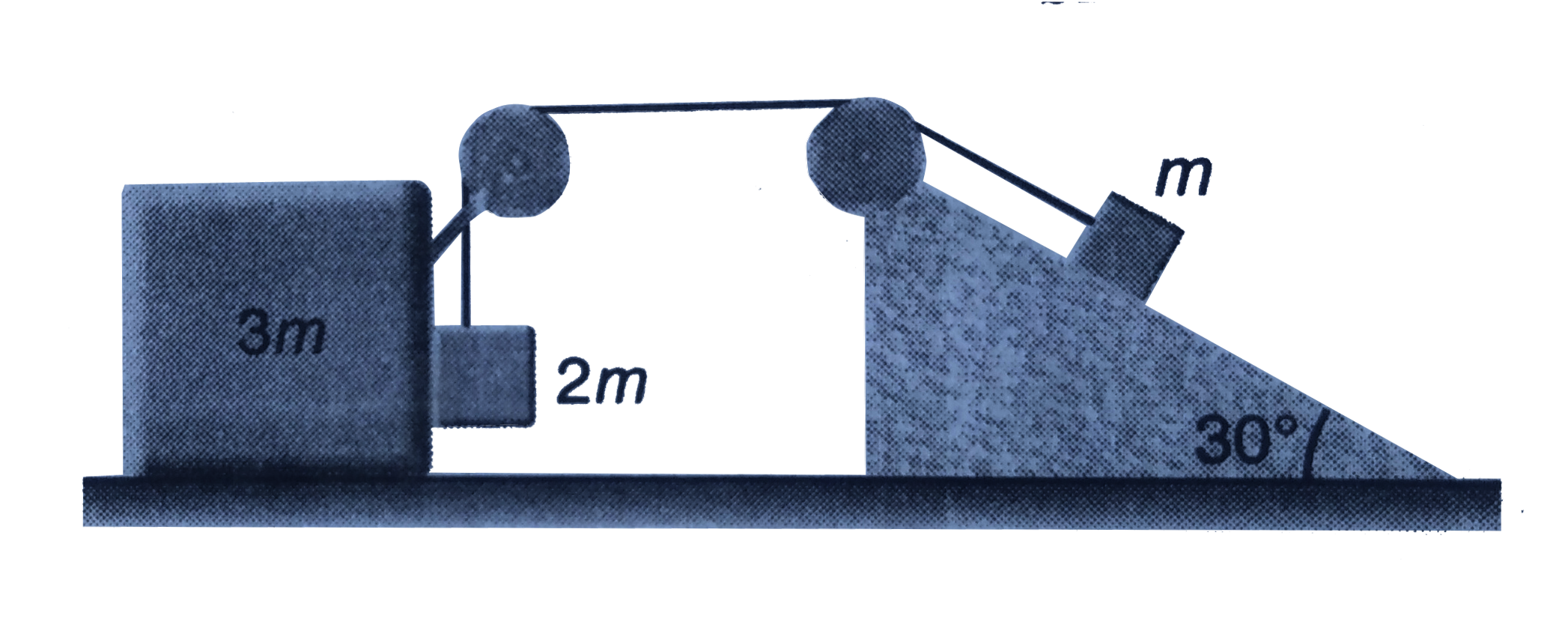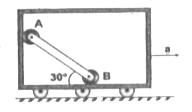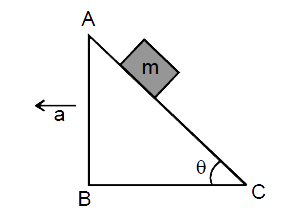Neglect friction. Find acceleration of as shown in the figure. The wedge is find.

Writing equation of motion ,
…(i)
…(ii)
…(iii)
…(iv)
From constraint equation,
…(v)
We have five unknown . Solving the above five equatin, we get

, and
Acceleration of
Acceleration of
and acceleration of
Topper's Solved these Questions
- LAWS OF MOTIONBOOK - DC PANDEYCHAPTER - LAWS OF MOTIONEXERCISE - example
86 Videos
- LAWS OF MOTIONBOOK - DC PANDEYCHAPTER - LAWS OF MOTIONEXERCISE - Check point 5.1
20 Videos
- LAWS OF MOTIONBOOK - DC PANDEYCHAPTER - LAWS OF MOTIONEXERCISE - Comprehension
9 Videos
- KINEMATICS 1BOOK - DC PANDEYCHAPTER - KINEMATICS 1EXERCISE - INTEGER_TYPE
15 Videos
- LAWS OF THERMODYNAMICSBOOK - DC PANDEYCHAPTER - LAWS OF THERMODYNAMICSEXERCISE - Level 2 Subjective
18 Videos
Similar Questions
Find the acceleration of the prism of mass M and that of the bar of mass m shown in figure.

View SolutionIf a car is moving rightward with acceleration a=g√km/s rightward as shown in the figure. Find the value of k so that, rod maintains its orientation as shown in the figure. Neglect the friction and mass of the small roller at A and B.

View Solution
Knowledge Check
A block of mass m resting on a wedge of angle θ as shown in the figure. The wedge is given an acceleration a. What is the minimum value of a so that the mass m falls freely ?
 AgBgcosθCgcotθDgtanθ
AgBgcosθCgcotθDgtanθBlock A of mass m and block B of mass 2m are placed on a fixed traingular wedge by means of a massless inextensible string and a frictionless pulley as shown in figure The wedge is inclined at 45∘to the horizontal on both sides .The coefficient of friction between blocks A and the wedge is 2/3 and that between block B and the wedge is 1/3. If the system A and B is released from rest find the following

The acceleration of A isA0B1C2D3
A block of mass m is at rest relative to the stationary wedge of mass M. The coefficient of friction between block and wedge is μ. The wedge is now pulled horizontally with acceleration a as shown in figure. Then the minimum magnitude of a for the friction between block and wedge to be zero is:A>anθBμ>anθCgcotθDμgcotθ
Find the acceleration of masses m1,m2 and m3 shown in figure-2.119 just after the string is cut at point A.

[0,(1+m1m2)g,g]
View SolutionA rod of mass m is supported on a wedge of mass M shown in fig. Find the accelerations of rod a and wedge A in the arrangment. The friction between all contact surfaces in negligible.

View SolutionIn the arrangement shown in figure the masses of the wedge M and the body m are known. The appreciable friction exists only between the wedge and the body m, the friction coefficient being equal to k. The masses of the pulley and the thread are negligible. Find the acceleration of the body m relative to the horizontal surface on which the wedge slides.

View SolutionIn the arrangement shown in figure, the rod of mass mhelp by two smooth walls, remains always perpendicular to the surface of the wedge of mass M. Assuumming all the surface to be frictionless, find the acceleration of the rod and that of the wedge.

View SolutionA rod of mass m2 rests on wedge of mass m1 (Fig.). Guides allow the rod to move only in the direction of the y-axis and the wedge only in the direction of the x-axis. Find the acceleration of both bodies and the reaction of the wedge. Neglect friction.

View Solution
